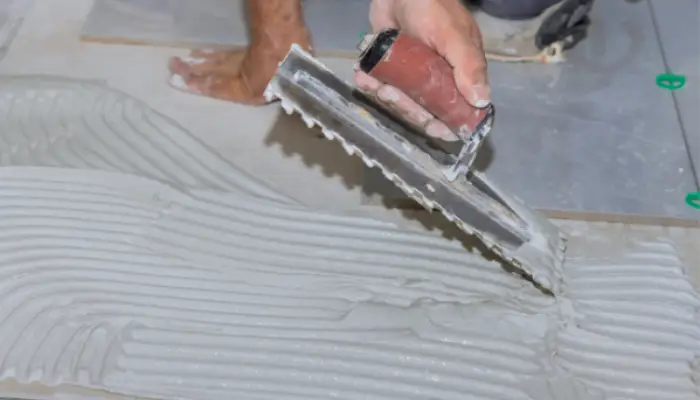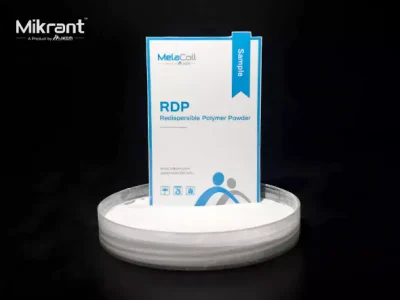
Fayans oyulması ve dökülmesi, fayans yapıştırma endüstrisinde yaygın bir sorun olmuştur. Hem ev sahipleri hem de inşaatçılar için baş ağrısına neden olmaktadır. Ancak, RDP'nin piyasaya sürülmesi karoların döşenme biçiminde devrim yaratmıştır. Bu sorunların ortaya çıkmasını azaltır. Bu makalede, RDP'nin nasıl RDP çalışmaları ve karodaki uygulamaları.
1. Yeniden Dağılabilir Polimer Tozuna Giriş

RDP, polimer emülsiyonlarının kurutulması ve toz haline getirilmesinden elde edilen bir üründür. Bu tozlar su içinde yeniden dağıtılabilir. Nihai olarak kararlı dispersiyonlar oluşturur. RDP, aşağıdakiler de dahil olmak üzere çeşitli inşaat uygulamalarına uygulanabilir fayans yapıştırma harçları.
Fayans yapıştırıcılarında RDP kullanımı performansta önemli gelişmelere yol açmıştır. Yapışma mukavemetini artırır, büzülmeyi azaltır ve su emilimini düşürür. Bu geliştirmeler RDP'yi modern karo döşeme yöntemleri için tercih edilen seçenek haline getirmiştir. Geleneksel kum-çimento harçlarının yerini alabilir.
2. Yeniden Dağılabilir Polimer Tozu Oyulmayı Nasıl Azaltır?

Karo ile alt tabaka arasında genellikle yetersiz yapışma kurs karosu oyma. Bu durum, karo yüzeyinin altında hava boşluklarına veya boşluklara yol açar. Fayansın oyulması fayansın dökülmesine neden olur. Fayans dökülmesi, yetersiz yapışma nedeniyle fayanslar alt tabakalarından ayrıldığında meydana gelir.
2.1 Yeniden Dağılabilir Polimer Tozunun Fayans Yapışmasını İyileştirmedeki Rolü
İçine dağılabilir lateks tozu ekleyebilirsiniz. Fayans yapıştırıcısının formülü. İlk olarak, RDP fayans yapıştırıcısının moleküllerine dağılacaktır. Ve sonra fayans yapıştırıcısının yüzeyini ıslatır. Bu, moleküller arasındaki mesafeyi azaltır. Güçlü moleküller arası kuvvetler, karoları sıkı bağlantılarla bir araya getirecektir. Yoğun karolarda, hala güçlü bir kuvveti koruyabilir.
RDP, çimento partiküllerini ve dolgu maddelerini birbirine bağlayan polimerik bir ağ oluşturur. Bu ağ yapısı, karo ile alt tabaka arasındaki genel yapışmayı geliştirir. Bu, yoğun karolarda bile daha güvenli bir bağ sağlar ve karo dökülme olasılığını azaltır.
2.2 Yeniden Dağılabilir Polimer Tozu ile Esnekliğin Artırılması
Yeniden dağılabilir polimer tozu, karo yapıştırıcısının genel yapışmasını ve esnekliğini artırır. Ayrıca yapıştırıcının dış kuvvetlere ve yüksek sıcaklıklara karşı direncini artırır. RDP ayrıca fayans yapıştırıcısının esnekliğini artırmada da önemli bir rol oynar.
Özellikle karo boyutu arttığında, karo oyuklarının oluşma olasılığı daha yüksektir. Fayanslar dış ve iç etkenlerden dolayı deforme olacaktır. Bu yüzden karolar deformasyondan kaynaklanan gerilmeleri absorbe etmelidir. Bu da karoların esnekliğini gerektirir.
Karo esnekliğini iki faktör etkiler. Birincisi, çimentolu malzemenin hidrasyon derecesidir. İkincisi ise fayans yapıştırıcısı içinde bir polimer ağının oluşmasıdır. Fayans yapıştırıcı formülasyonlarında, çimento, kum ve diğer inorganik malzemeler çeşitli fayans yapıştırıcılarının sertliğini sağlar. Polimer tozu ise esneklik sağlar. Çimentonun hidrasyon derecesi ne kadar yüksek olursa, malzemenin sertliği o kadar güçlü olur. malzeme kırılgandır ve esneklik azalır.
Polimer içeriği polimer ağının bütünlüğünü etkiler. Çimento taşının gözeneklerindeki polimer bir polimer ağı oluşturur. Polimer daha az olduğunda, ağ yapısı daha eksiktir. Bu yüzden malzemenin esnekliği daha düşüktür. Deformasyon meydana geldiğinde, polimer ağı gerilimi emer. Rijit bileşenlerin çatlamamasını ve hasar görmemesini sağlar.
Fayans yapıştırıcısının kendisi deformasyonun neden olduğu gerilimi tamamen ememez. Bu nedenle, karoların dökülmesini azaltmak için dağılabilir lateks tozu eklemek gerekir.
2.3 Dış Kuvvetlere ve Yüksek Sıcaklığa Karşı Geliştirilmiş Direnç
RDP, darbe, titreşim ve yüksek sıcaklıklar gibi dış kuvvetlere karşı direnci artırır. Bunun nedeni, dağılabilir polimer tozunun iki veya daha fazla polimer içermesidir. Polimer bileşim oranı farklıdır ve sertliği de farklıdır. Sertlik sıcak ortamlarda çok önemli bir faktördür. Kauçuk tozu ne kadar sert olursa, aynı sıcaklıkta yumuşama derecesi o kadar düşük olur. Ve yüksek sıcaklıklarda dış kuvvetlere karşı koyma yeteneği daha güçlüdür.
Dolayısıyla, yüksek sıcaklıktaki ortamlarda bile fayans yapıştırıcıları uzun bir açık kalma süresine sahiptir. Fayans yapıştırıcısı uygun şekilde korunmadığında, fayans konumunu düzeltmek için zamanınız olabilir. Bu özellikle mutfak, banyo ve balkon gibi ortamlarda önemlidir. Fayanslar bu yerlerde değişken sıcaklıklardan ve nem seviyelerinden muzdariptir. RDP, yapıştırıcının kabiliyetini artırarak karoların dökülme riskini azaltır.
3. Modern Fayans Döşeme Yöntemlerinde Yeniden Dağılabilir Polimer Tozunun Rolü

Fayanslar çoğunlukla duvarları ve zeminleri kaplamak için kullanılır. Ancak teknoloji gelişmeye devam ettikçe, modern karolar her zamankinden daha büyük ve daha yoğundur. Bu nedenle, fayansların uzun süre nasıl sağlam tutulacağı çok önemlidir.
RDP polimer tozunun piyasaya sürülmesi, modern karo döşeme yöntemlerinin önünü açmıştır. Bu yöntem ince tabaka harç teknolojisini içerir. Bu yaklaşım, 3-4 mm kalınlığında ince, düzgün bir yapıştırıcı harç tabakasının kullanılmasını içerir. Ancak geleneksel kalın katman yöntemi 10-25 mm'lik bir harç katmanı gerektirir.
3.1 İnce tabaka harç teknolojisi
İnce katmanlı harç teknolojisi, geleneksel kalın katmanlı yöntemlere göre aşağıdakiler de dahil olmak üzere çeşitli avantajlar sunar:
Avantajlar
1. Daha düşük malzeme tüketimi
2. Daha hızlı ve kolay kurulum
3. Daha fazla maliyet etkinliği
4. Daha geniş bir uygulama yelpazesi
5. Doğrudan güneş ışığı, sıcak ve soğuk gibi aşırı ortamlarda asfaltlama gereksinimlerini karşılayın.
6. Geliştirilmiş performans ve dayanıklılık
Dezavantajlar
1. İnce macun işleminin duvarın ve zeminin düzlüğü konusunda yüksek gereksinimleri vardır. Düzlüğü zayıf olan taban katmanı için, tesviyeden sonra ince macun yönteminin kullanılması önerilir.
2. Bu avantajlar, ince tabaka harç teknolojisini modern karo kurulumları için tercih edilen seçenek haline getirmektedir. Yeniden dağılabilir polimer tozu, başarısında kritik bir rol oynamaktadır.
3.2 Kalın macun
Avantajlar
1. "Kalın macun" teknolojisinin yapım fiyatı ucuzdur.
2. Duvarın ve zeminin düzlüğüne ilişkin daha düşük gereksinimler.
Dezavantajlar
1. "Kalın yapıştırma" işleminin inşaat hacmi büyüktür,
2. İnşaat mukavemeti için gereksinimler yüksektir,
3. Ve malzemelerin kalitesi kontrol edilemez.
Bu yöntem, inşaat personelinin kapsamlı deneyime sahip olmasını gerektirir. Ve büyük miktarda malzeme tüketir. Yanlış işlem veya yanlış çimento harcı oranı karoların düşmesine neden olabilir.
RDP, çimento karo yapıştırıcısı ve polimer modifiyeli ince set harcı dahil olmak üzere çeşitli karo yapıştırıcı formülasyonlarına uygulanabilir. Bu yapıştırıcılar, farklı karo türleri ve yüzeyler için optimum performans sağlayabilir. Güvenli ve uzun ömürlü bir kurulum sağlar.
Polimer modifiyeli ince set harcı, çimento, kum ve RDP'yi birleştiren bir yapıştırıcı türüdür. Bu formülasyon, geleneksel kum-çimento harcı ile karşılaştırıldığında gelişmiş performans sunar. RDP, güvenli bir karo montajı için gerekli esnekliği ve yapışma gücünü sağlar.
Karo döşemesinde RDP polimer tozu kullanırken en iyi sonuçları elde etmek için, aşağıdakiler de dahil olmak üzere en iyi uygulamaların takip edilmesi önemlidir:
1. Belirli bir uygulama için uygun RDP ürününün seçilmesi
2. Fayans yapıştırıcısı ve suyun eşit şekilde karıştırılması
3. Düzgün bir tabaka oluşturmak için tırtıklı mala kullanarak yapıştırıcının uygulanması
4. RDP'nin karo ve alt tabaka ile güçlü bir bağ oluşturmasını sağlamak için uygun kürleme koşullarının sağlanması
5. Bu en iyi uygulamaları takip ederek, karo döşeme projelerinizde yeniden dağılabilir polimer tozunun faydalarını en üst düzeye çıkarabilirsiniz.
4. Fayans Yapıştırıcıları Formülasyonunda Yeniden Dağılabilir Polimer Tozu
Formülasyonlarında yeniden dağılabilir polimer tozu içeren çeşitli fayans yapıştırıcıları vardır. Bazı popüler markalar şunlardır:
1. Wacker'in VINNAPAS® 5010N ve VINNAPAS® 8620E
2. BASF'nin Acronal® serisi
3. Dow'un WALOCEL™ serisi
4. Mikem'in Mikrant™ serisi
Bu ürünler farklı karo tesisatlarının özel ihtiyaçlarını karşılayabilir. Optimum performans ve dayanıklılık sağlarlar.
Bu ürünlerin avantajları şunlardır
1. Çeşitli uygulama koşulları altında farklı yüzeylere mükemmel yapışma
2. Yüksek sıcaklıklarda bile uzun açık ve doğru süreler.
3. Genişletilmiş açılış ve ayarlama saatleri
4. Uyum gücünü artırın
5. Esnekliği artırır ve alt tabaka ile karo arasındaki gerilime bağlı çatlakları önler. Alt tabaka ile fayans yapıştırıcısı arasındaki gerilim çatlaklara neden olabilir. Dağılabilir lateks tozu eklemek bunun olmasını etkili bir şekilde önleyebilir.
6. Enerji tasarrufu. İnşaat malzemelerinin azaltılması, üretimden kaynaklanan karbondioksit salınımını azaltır. Ve üretim verimliliğini artırır ve süreyi kısaltır.
5. Sonuç
Yeniden dağılabilir polimer tozu, karo döşeme dünyasında devrim yaratmıştır. Yapışma, esneklik ve genel performansta önemli gelişmeler sunar. İnce katmanlı harç teknolojisi gibi modern karo döşeme yöntemlerinde kullanılabilir. RDP, daha hızlı, daha uygun maliyetli ve daha uzun ömürlü kurulumlara olanak sağlamıştır.


Bir Cevap Bırakın